The Brazos Review: AMD's E-350 Supplants ION for mini-ITX
by Anand Lal Shimpi on January 27, 2011 6:08 PM ESTHeavy Lifting: Performance in Complex Workloads
Brazos is clearly faster than Atom in light workloads, but what about in more complex/heavier applications? Are the Bobcat cores enough to allow E-350 systems to move up in the world or will they still be confined to the web browsing/email usage models of netbooks? I've run the E-350 through our entire Bench suite to find out. If you want the full gamut of results head over to CPU Bench, but I've chosen a few here. I also included performance results from a 2.66GHz Pentium 4 to put things in perspective for users of really old systems.
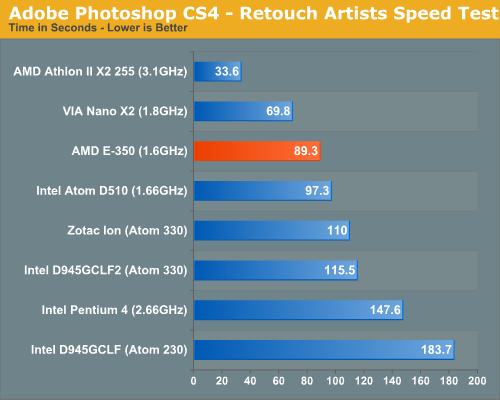
Photoshop CS4 performance is not half bad on the E-350 compared to other similarly priced platforms. Also impressive is the E-350's performance advantage over the old Pentium 4. Compared to the Athlon II X2 however the E-350 is still noticeably slower.
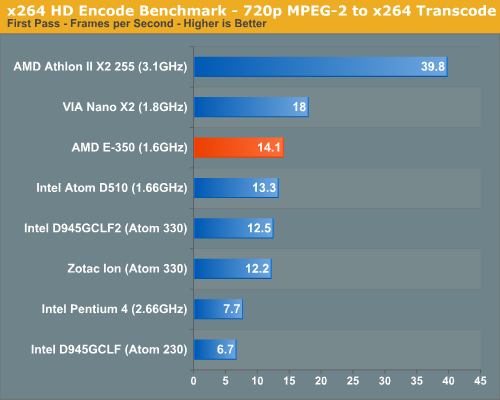
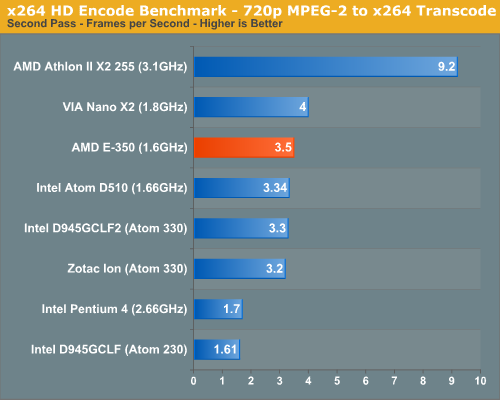
The standings and performance trends continue in our x264 encode benchmark. I don't expect you to do a lot of video transcoding on the E-350 as it's not much faster than Atom here. VIA's dual-core Nano is a bit quicker but still not enough to make this a viable usage case.
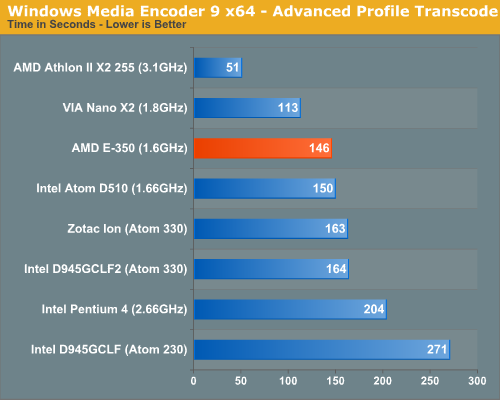
Windows Media Encoder provides a far lighter workload, but the standings don't change. The E-350 is faster than anything Atom based, faster than the old Pentium 4, but slower than VIA's Nano X2.
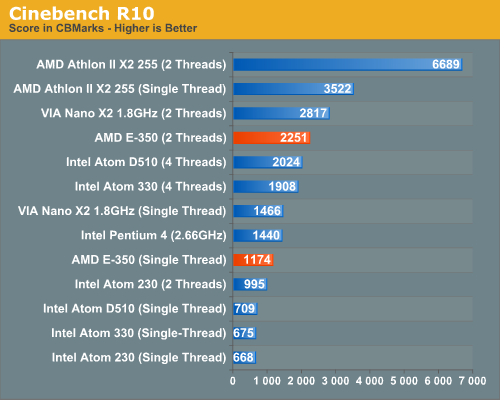
While I don't expect E-350 users to do any offline 3D rendering work, Cinebench does give us a good characterization of single threaded performance. The problem with Atom is that its single threaded performance isn't nearly as good as its multithreaded performance. In all of the previous benchmarks an Atom D510 is clearly quicker than the old 2.66GHz Pentium 4, but looking at single threaded Cinebench R10 you get a different story entirely. The P4 has nearly twice the single threaded performance of an Atom D510.
The E-350 is still a bit behind the Pentium 4 in single threaded performance, but it's not nearly as bad as Atom. The out-of-order execution engine helps tremendously here. What you get as a result is a system that doesn't really feel slower than a 5 year old PC but has the features of a more modern system.
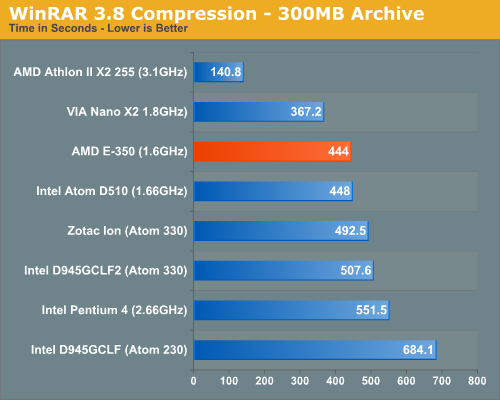
Overall the E-350 is clearly faster than Atom ever was at running these heavier workloads. The highly threaded workloads aren't much faster on E-350 vs. Atom thanks to the latter's Hyper Threading , but single threaded performance continues to play an important role and is a huge advantage of AMD's. VIA's simple out-of-order architecture is consistently faster than the E-350, however I don't expect to see widespread adoption or support for VIA's platform (at least compared to AMD's). Compared to the larger out-of-order x86 cores the E-350 is still in a lower performance class, the Athlon II X2 is easily twice as fast as the E-350 in these tests.
Ultimately the same rules that applied to Atom based systems apply to Brazos systems:
1) Swapping to disk is painful so you need enough memory (I'd recommend no less than 2GB for Windows 7, ideally 4GB) and you'll want a fast HDD. My preference is still an SSD, even a low end value drive over even a fast hard drive. Even a low end SSD (e.g. Kingston SSDNow V100) will make a Brazos system feel acceptably fast.
2) Outside of media playback and some gaming, you're still limited in the types of applications and workloads you can run on Brazos. The Brazos platform is great for web browsing/email workloads, but don't try to do too much more with it. The advantage over Atom here is that Brazos just does those things noticeably faster.










176 Comments
View All Comments
Matt310 - Friday, January 28, 2011 - link
At home in my desktop machine I have a 4-lane PCI-x hardware RAID card with four 1.5TB drives configured in RAID 5 for speed hand fault tolerance. For a while now I've been wondering how the i/o performance of a good RAID card would fair if it was moved to a low-power (e.g. Atom- or Brazos-based) mini-ITX NAS system. I've been googling for a review of this setup but not been able to find anything conclusive.Think a lot of people would appreciate if you guys could give this a try and report on your findings!
Thanks Anand!
msroadkill612 - Friday, February 4, 2011 - link
Well you should know - dont the raid cards have their own smarts & put little work on the cpu?My guess is it would be a great unit for a dedicated server. In the old days, many dedicated servers kept their 486 pcS for a decade as they ran fine.
a post above linked to a comparison of running pciE graphics cards at 1,4,8,16 lanes, & the difference between 4 x &16 by was slight. I imagine its the same with raid cards.
jjcrandall - Friday, January 28, 2011 - link
Anand, I didn't see what hdd you used for the tests. It would be very interesting to see how this platform performed in some of the benchmarks with a ssd. I know pcmark & vantage productivity benches use hdd test's to a certain degree.This really shows either how poor netburst was as an architecture, or how good existing sub 10w designs are.
Shadowmaster625 - Friday, January 28, 2011 - link
It seems like the E-350 was built for overclocking. Especially on the desktop or with any cooling solution that has an extra 10 Watts of thermal headroom. Sooner or later someone is going to release a mini-ITX board that can OC an E-350 up to 2.5GHz and beyond. Right? It's not like the new intel cpu where you cannot overclock it, right?bjacobson - Saturday, January 29, 2011 - link
yeah I definitely want to overclock it!In a laptop when you've got an 8-10 hour battery life, if you know you're only going to need the laptop for 4 hours today, why not just crank up the speed? Great having that option.
Arnulf - Friday, January 28, 2011 - link
"Unfortunately in modern titles that's not always enough to have a playable experience, but with older games you should be able to do more with Brazos than you ever could with Atom or even ION for that matter. The CPU/GPU balance in the E-350 is good enough that I feel like Llano could make for a pretty decent value gaming machine."Given that Zacate/Brazos performs at the level of 5+ years old midrange desktop CPU with midrange GPU and considering the quoted statement above it would be very interesting to see some actual performance data taken in titles that Zacate/Brazos *can* run at bearable FPS rates.
You could look up your performance charts from 5 years ago, dig out the old titles and rerun the benchmarks with those titles on Zacate/Brazos. This should give people better idea what they can expect from this generation of APUs. Sub-20 FPS rates in modern titles at rather low resolution and with all details at minimum isn't exactly what people have their sights on when deciding whether to shell out money for their new toy. Comparison with other crappy graphics that is on par with 5 year old solutions may give AMD's platform some edge over competition from Intel's camp, but it utterly meaningless as nobody is planning to use it in such setting.
Myself, I'd *love* to see some factual data from titles such as CoD2, DiRT, Doom3, etc. - the games you were referring to in the paragraph quoted above and all of which you already have reference benchmarks of (in order to have something to compare Zacate/Brazos against, without having t rerun all the benchmarks with old software titles). Such a benchmark with usable performance and enough eye candy will help put Zacate/Brazos' use in gaming setting into perspective, very much unlike those ~20 FPS tests you did above.
These merely indicate that integrated graphics of today are still useless for gaming.
bjacobson - Saturday, January 29, 2011 - link
Hm that's a good point. Likely I'd be playing a copy of UT2k4, perhaps quake 3 online, or some older online RTS. How do these fare at those games?cjs150 - Friday, January 28, 2011 - link
Nice review.There is a passively cooled E-350 board coming out. The review convinces me that this will be the right choice for the HTPC for the main room.
Why: TV already connected to an AV receiver so an E-350 system can use the HDMI connection to the AV receiver. E350 more than powerful for BluRay, fine for some light web surfing, ripping music. Maybe stick a TV tuner in as well and that is the main room sorted.
I have no intention of playing modern games on it so lack of power is not a problem. I have a bigger PC in study to rip movies if it takes too long on the E350.
But I also have an Atom based system. Again passively cooled. I use it as a server for the home network. It works just fine. It was cheap, ultra easy to build and just works. The fact that Atom is rubbish does not matter because as long as it can shift data round the network I need nothing more.
So every CPU has a purpose, just with some we have to look hard
BernardP - Friday, January 28, 2011 - link
AMD might score technical successes with its new lineup (Bobcat, llano, Bulldozer), but it will have trouble marketing them if only meaningless C Series, E Series, A series (Llano) and whatever Series (Bulldozer) are used.last time I looked, a C350 and E350 were Mercedes-Benz models, while CSeries is an upcoming Bombardier jet:
http://en.wikipedia.org/wiki/Bombardier_CSeries
In addition the numbers seem meaningless. Even intel's Core naming scheme is clearer than AMD's.
AMD simply needs 3 distinct marketing names that the general public will understand for its 3 new product lines code names: Bobcat - Llano - Bulldozer. "Fusion" and "Vision" just don't cut it anymore, as they have already been used for years by AMD.
One can easily see that there is a problem is the naming scheme when OEMs have to use the Zacate and Brazos code names to try to describe the product, like this example:
http://www.asus.com/product.aspx?P_ID=9BmKhMwWCwqy...
nitrousoxide - Friday, January 28, 2011 - link
Yeah...the naming scheme ASUS and ACER use makes people mad when choosing laptops :)